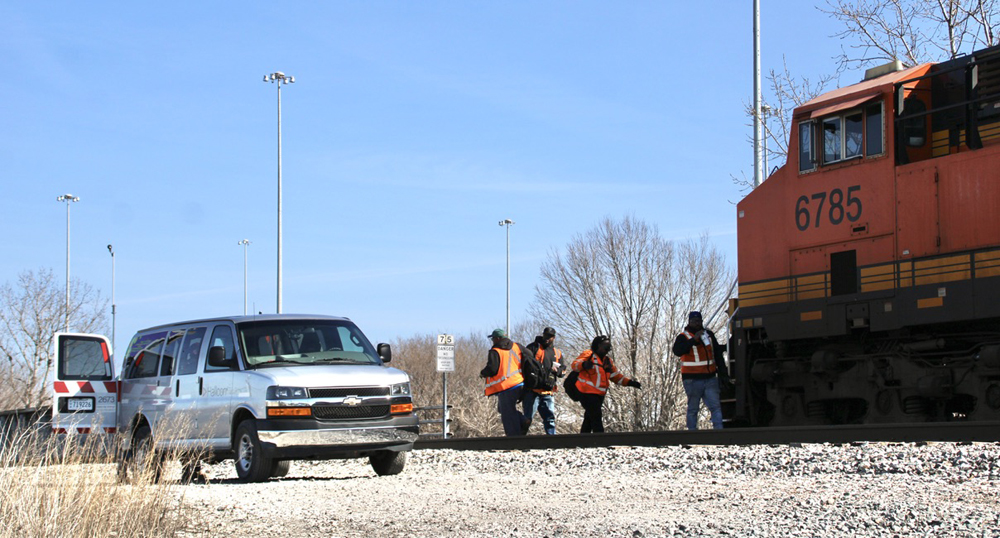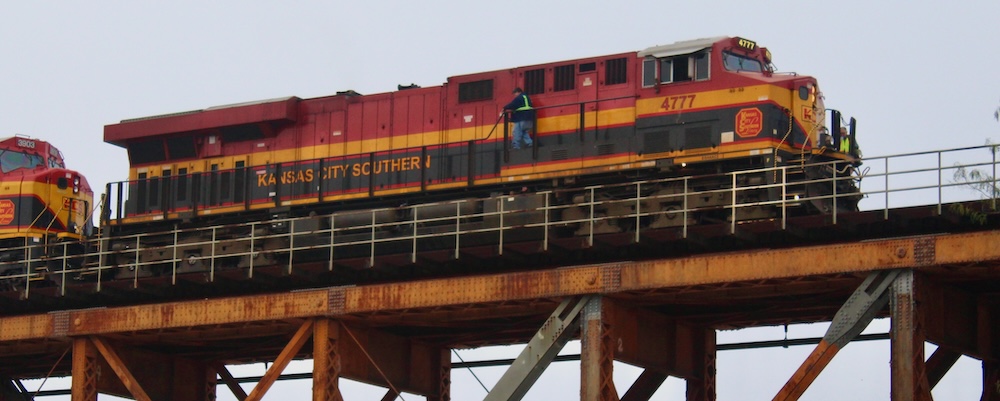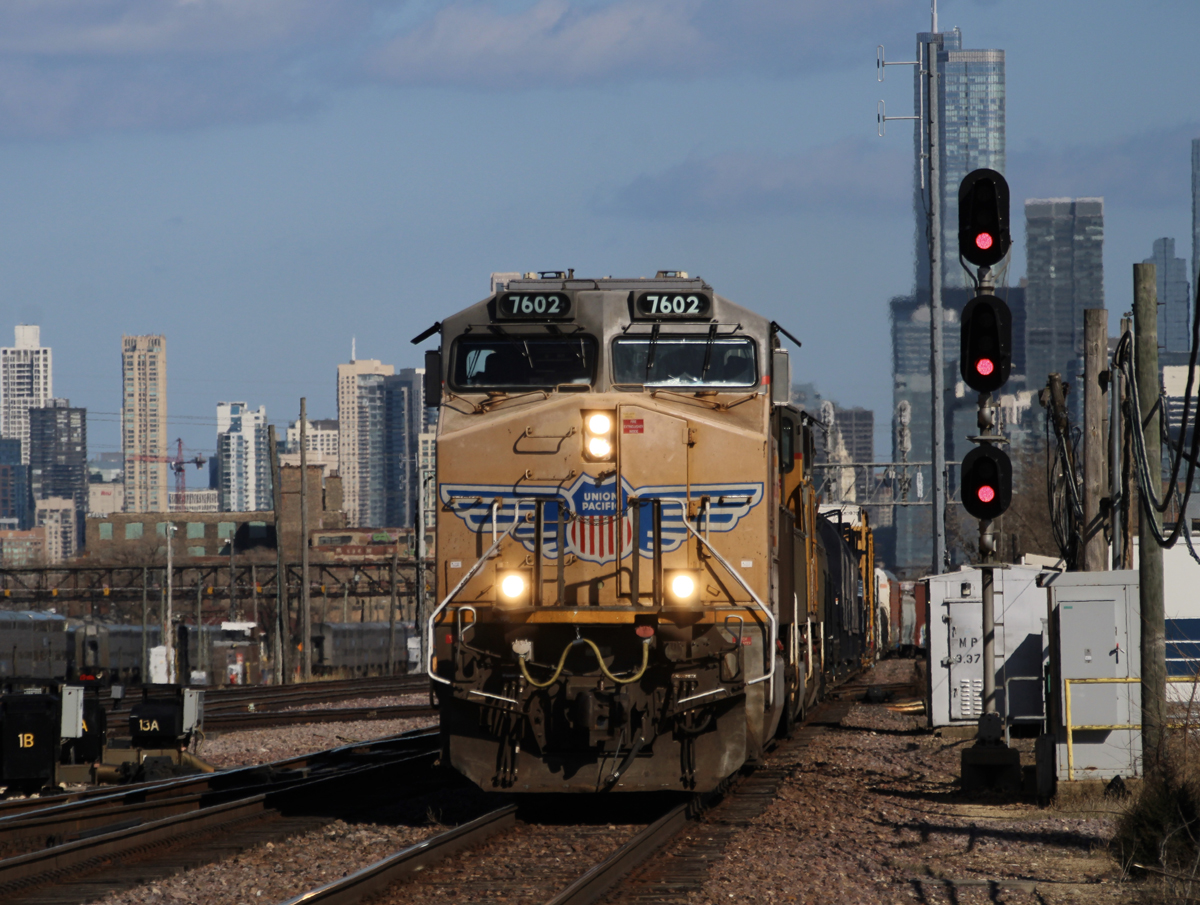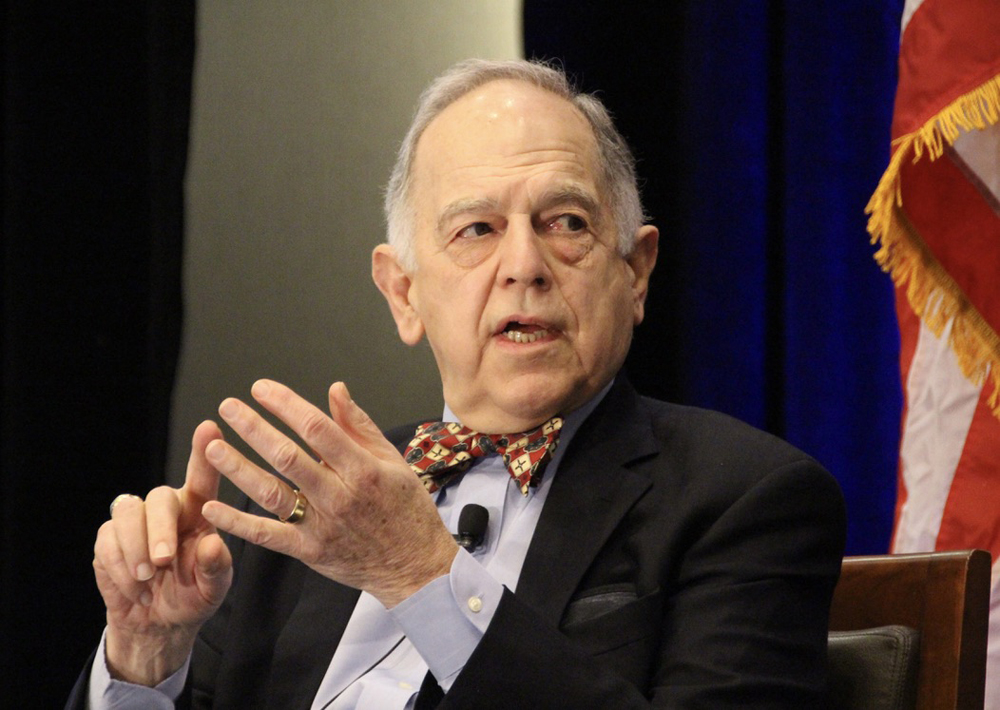
WASHINGTON — The Federal Railroad Administration today issued its new final rule generally requiring two-person crews on trains, which it says “enhances safety” and industry group the Association of American Railroads immediately blasted as “unfounded and unnecessary.”
The 223-page final rule requires two-person crews except for certain operations “that do not pose significant safety risks to railroad employees, the public, or the environment,” allows some some existing one-person operations to continue, and includes a process for approving new one-person operations; those receiving approval for one-person operations must submit an annual report to the FRA summarizing the safety of the operation.
“Common sense tells us that large freight trains, some of which can be over 3 miles long, should have at least two crew members on board — and now there’s a federal regulation in place to ensure trains are safely staffed,” Transportation Secretary Pete Buttigieg said in a press release. “This rule requiring safe train crew sizes is long overdue, and we are proud to deliver this change that will make workers, passengers, and communities safer.”
The AAR, meanwhile, emphasized a lack of evidence connecting crew size to safety, and noted the FRA had dropped a similar rule in 2019 [see “FRA withdraws proposed minimum crew size rule,” Trains News Wire, May 24, 2019]
“FRA is doubling down on an unfounded and unnecessary regulation that has no proven connection to rail safety,” AAR President and CEO Ian Jefferies said in a statement. “Instead of prioritizing data-backed solutions to build a safer future for rail, FRA is looking to the past and upending the collective bargaining process.” He cites a 63% drop in the casualty rate for employees since 2000 and a 27% decrease in overall the overall train accident rate in the same period, as well as a 6% decline since 2022.
“Railroads are committed to working with our union counterparts and policymakers to build on this momentum and advance proven solutions that meaningfully advance safety,” Jefferies said. “Unfortunately, the crew size rule takes the industry in the exact opposite direction.”
The FRA says the rule “closes a loophole” that allowed railroads to initiate single-crew operation without performing risk assessment, mitigating risks, or even notifying the agency. It also says it differs from the initial rule proposal by giving smaller Class II and III railroads the opportunity to continue or initiate one-person operations by notifying the FRA and complying with new federal safety standards.
The federal action comes at a time when states have increasingly legislated for two-person crews. At least 11 states have passed two-person crew laws, although their ability to withstand legal scrutiny remains in question because of federal right to oversee matters of interstate commerce.
The AAR says the rule is an “overreach” into an area historically addressed through collective bargaining, and will diminish the importance of the bargaining process by inserting the regulator between the parties. Unions, however, praised the FRA action.
“This rule acknowledges that crew size is fundamentally a safety issue at its core,” Greg Regan, president of the Transportation Trades Department of the AFL-CIO, said in a statement. “Rail workers experience the risks of the job daily, and have made it clear that two-person crews are inherently necessary to ensure the safe operation of our rail systems. While the FRA has considered action on crew size for almost a decade, operational and safety changes across the rail industry the last several years have only heightened the need for strong crew size regulations.”
Brotherhood of Locomotive Engineers and Trainmen President Eddie Hall said his union has advocated for a two-person crew rule for 13 years and has sought it in collective bargaining. “As trains, many carrying hazardous material, have grown longer, crews should not be getting smaller,” Hall said in a statement. “I personally have operated freight trains that stretched over 3 miles in length. … Today’s announcement is an important step in making railroading safer in every state, rather than a piecemeal approach.”
The International Association of Sheet Metal, Air, Rail, and Transportation Workers-Transportation Division (SMART-TD) said the rule “solidifies the role of freight conductors in this country” and said that union officials “pushed lawmakers and government officials to understand the ramifications of a nation with single-person freight crews.” The union’s president, Jeremy Ferguson, called the decision “historic for SMART-TD members and all rail labor. Today’s ruling codifying the two-person freight crew not only demonstrates this administration’s dedication to the safety of this country and our workforce, but it also shows their respect and acknowledgment of our men and women and the work they do.”
U.S. Sen. Sherrod Brown (D-Ohio) reacted positively to the FRA rule and used the occasion to call for passage of the long-stalled Railway Safety Act, the post-Palestine derailment bill which includes a two-person-crew provision as well as regulations regarding wayside detectors, among other provisions [see “Senate to schedule vote …,” News Wire, Jan. 14, 2024].
“No one wants a miles long train barreling through their community with only one operator,” Brown said in a statement. “This is an important first step to protect communities—but we must pass the Railway Safety Act to make trains carrying hazardous materials safer and ensure railroad lobbyists can’t roll back the two-person crew rule in the future.”
— Updated at 10:34 a.m. CDT with reactions from BLET, SMART-TD, U.S. Sen. Sherrod Brown.














As a retired locomotive engineer, I spent many a night operating without a conductor on a 100 mile run.
I always lived in fear that something would go wrong. Many times it did! One night the train went into emergency. The air wouldn’t pump up, so I had to leave the cab and hike back examining the train for the cause. Fortunately, just before a trestle where I would have had to climb along the tops of cars to continue, I found a car blowing air. I cut out the air brakes on that car and was able to get my train pumped up.
Two people in the cab is a must! A friend saved his engineer’s life when he was able to perform the heimlic maneuver because the engineer was choking on his sandwich.
This is a no brainer!
Railroads make money. They just don’t make enough money for the hedge fund sharks who care nothing about the railroads, railroaders or the communities they go through. That is what 1 man crews are all about. Class I railroads need 2 person crews. As for the others, it could be better not written in stone, since each situation is different. It depends on how reasonable the administration of it is.
Comparing Australian RRs hauling ore to US railroads hauling everything is nonsensical. Nobody cares if a bunch of ore gets derailed in the outback. Everyone cares of hazardous materials derail in the US.
As for self insurance, it is ridiculous. Self insurance means the railroad is promising to pay. They would fight forever to pay damages to anybody and deny responsibility then declare bankruptcy.
So far, questions about trains on Class 2 and 3 roads seem unclear. Query: On a switching job with an engineer and conductor/brakeman, is that a qualifying “two-person” crew even when the conductor is on the ground throwing switches, coupling/uncoupling cars, setting/releasing car brakes, consulting with customers, etc? How much paperwork and permit work will be required for the little guys to continue normal ops?
I would put the second person in a truck with high speed road railers and let them attach themselves at the back of the consist. Brake hose? Overheated bearing? The truck would have the live telemetry from the detectors along the route and work with the engineer in the forward cab on what actions to take.
Train stops suddenly, truck detaches from the back of train and drives up to the bad car/derailed car and makes a judgement while the lead engineer watches his air gauges and talks with the dispatcher on the loop on status.
This would comply with the new FRA rule, but still allows the C1’s to have a truck based conductor.
This would be extremely dangerous for the person in the truck. Imagine a truck being tossed from the rails when the cars in front of them derail!
No one in their right mind would sit in the can of that high railer.
In my gut I want to see 2-person crews preserved. I guess that’s because I’m a retired rail although I was not in train service. But when my head takes over I want to ask SecTrans Buttigieg what he will do about autonomous long-distance tractor trailer trucks. Front page in the 4/1 Washington Post was this gem; “Ready or not, self-driving semis are coming to America’s highways”. If Buttigieg and a host of elected officials federal and state have a problem with 1-person freight crews on road freights on a fixed guideway they better have a problem with no person crew semis operating at high speeds on an unfixed guideway. But I’ll bet he and they don’t. I’ll bet they see no problem with the railroads having to design, build, operate, and maintain their rights-of-way AND PAY TAXES ON THAT ROW, and pay crew salaries and benefits while allowing trucking companies to field autonomous trucks on rights of ways they have zero responsibility for designing, building, operating, maintaining or paying taxes on.
So ok Petey, if you mandate that the freight railroads must keep 2-person crews, tell the hotshot techies at Aurora and other companies developing autonomous semis that they and the companies they think will buy them are forbidden to deploy such on “America’s highways”.
There will be derailments. East Palestine is an example. The conductor cuts the number of cars that can bel safely removed from a derailment. Engineer alone cannot do that by himself.
You bring up a very valid point. An engineer can NOT set out a car by their selves. If a hot wheel detector goes off sending a signal to the cab, the train must be stopped, inspected, and the defective car set out at the first available spot. If not, derailment is sure to follow.
Australia would beg to differ on the requirements for 2 person or even 1 person crews…and those iron ore trains are much longer and much heavier than anything we run here in the states. Why they even have autonomous operations of road freights with zero crew members and have had only 1 derailment since implementation, that is how you gather data and drive a real scientific study of the necessisity of having 1 or more crew members on board a moving train. Personally, someone on the ground might be able to see something that someone on the train couldn’t possibly see and might even be safer.
Did anyone from AAR ever work for the railroad? If they did, they couldn’t have been in train service.
The AAR appears to be made up of bean counters. A heartless breed who only lives for the love of money.
I believe Mr. Landey is a real person, since he knows of a favorite spot on the old Milw. ROW, i.e., Duplainville, where the former Wisc. Central crossed. That, however, does not excuse his off-topic rants.
CURTIS — Something has changed at Dupy. Traditionally, railfans like me would trespass right down to the junction. Now it’s far more common to view the action from legal public property, at a mid-distance.
I will look for you next time I’m there. I’m the 77-year-old guy on the Trek bicycle.
Sam, the railfan dog, has probably passed on by now. Sam lived a block east on Green Road, at the house with the salvaged Milwaukee Road signal masts by the driveway. Sam would range free down to the tracks. Nice dog!!!!
@Alex Charles is a regular and I think knows too much about railroading in specific areas of our country. His political output I would best describe as libratarian (sic?) and anti- what he sees as wasteful government spending. I can not say I agree with him much re policy and politics but I often learn a lot from him especially when his comments are about railroad operations or history.
Tom Just be aware that a two man crew won’t solve the sleeping issue, yes it can help.
In my career I’ve had derailments where both crew members have fallen asleep.
Thankfully they were all slow speed ones when they rear ended a stopped train ahead.
But we’ll never know how many times a second crew member in the locomotive woke the engineer up now will we.
I never thought I would agree with anything Buttigieg says but, I agree with 2 person crews. There is a history of an engineers falling asleep on a moving train. A second person in the cab is a safety factor because of that one thing only. If you do not think this is true, talk to an engineer in his 60’s. A large number will admit it has happened to them.
Agree fully. But it shouldn’t be Buttigieg, it should be the railroad’s own risk management people, making the decision.
Letting the railroads or airlines or trucking companies make their own risk assessments without government oversight. You must be kidding. I think your problem might just be with our current administration.
These railroad management types are like running water. It will always take the path of least resistance, without fail.
A 223-page rule? Disgusting. Time to shut down the federal government. Fire half its workers and cut the pay of the remaining half.
I could write a rule in two sentences. Let me try:
SENTENCE ONE: A federally regulated railroad shall (1) maintain a risk management staff appropriate to the carrier’s size and exposure to liability (2) shall provide proof of insurance and/or self-insurance for any foreseeable liability; and (3) shall conduct its operations in a manner such that the carrier’s insurance is and/or self-insurance is sufficient to cover any and all foreseeable risk.
SENTENCE TWO: Work the first sentence in conjunction with all rules and regulations pertaining to the licensing of operating personnel, along with any or all rules pertaining to the certification of locomotives, signals, PTC, communications and so forth.
Shut down the govt? Well, there goes Social Security, railroad retirement, Social Security-disability, interstate road works, navigable waterway management, the EPA, the postal service, the armed forces, and so on. Also, all our enemies (foreign and domestic) would suddenly walk into /all over the country without much fuss. Do you really hate the USA that much?
You must be troll. (possibly from Russia)
I would only make one change Charles… I would change “foreseeable” to “Reasonable.” Foreseeable is like a blank check. Reasonable is word with a legal description that can be measured. Environmentalist are ruining America by litigating on the basis of forseeable risk,, even if they can;t prove how something was foreseeable… Makes one wonder how we accomplish any useful expansion work in this country anymore…
Your rule said nothing about having 2 person crews or the method of requesting a reasonable use of 1 person crews. In case you didn’t know, without all the rules and regulation you either have 1, anarchy and everyone does what they want or 2, everything grinds to a halt and nothing gets done. Pick your poison Charles…which sounds better to you? Or perhaps neither of those options sounds good and you’ll let the government do it’s job, no matter how misguided it might be sometimes.